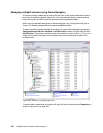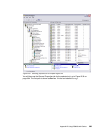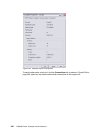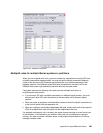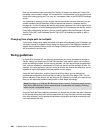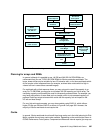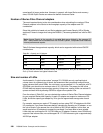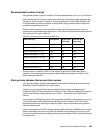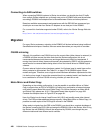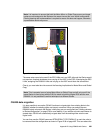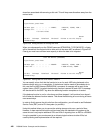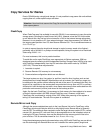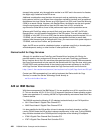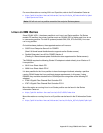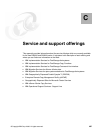400 DS8000 Series: Concepts and Architecture
Connecting via SAN switches
When connecting DS8000 systems to iSeries via switches, you should plan that I/O traffic
from multiple iSeries adapters can go through one port on a DS8000 and zone the switches
accordingly. DS8000 host adapters can be shared between iSeries and other platforms.
Based on available measurements and experiences with the ESS 800 we recommend you
should plan no more than four iSeries I/O adapters to one host port in the DS8000.
For a current list of switches supported under OS/400, refer to the iSeries Storage Web site
at:
http://www-1.ibm.com/servers/eserver/iseries/storage/storage_hw.html
Migration
For many iSeries customers, migrating to the DS8000 will be best achieved using traditional
Save/Restore techniques. However, there are some alternatives you may wish to consider.
OS/400 mirroring
Although it is possible to use OS/400 to mirror the current disks (either internal or external) to
a DS8000 and then remove the older disks from the iSeries configuration, this is not
recommended because both the source and target disks must initially be unprotected. If
moving from internal drives, these would normally be protected by RAID-5 and this protection
would need to be removed before being able to mirror the internal drives to DS8000 logical
volumes.
Once an external logical volume has been created, it will always keep its model type and be
either protected or unprotected. See Table B-1 on page 374 for DS8000 logical volume
models and types. Therefore, once a logical volume has been defined as unprotected to allow
it to be the mirror target, it cannot be converted back to a protected model, and therefore will
be a candidate for all future OS/400 mirroring, whether you want this or not.
Metro Mirror and Global Copy
Depending on the existing configuration, it may be possible to use Metro Mirror or Global
Copy to migrate from an ESS to a DS8000 (or indeed, any combination of external storage
units which support Metro Mirror and Global Copy). For further discussion on Metro Mirror
and Global Copy, please see 16.2.2, “Subsystem-based data migration” on page 339.
Consider the example shown in Figure B-35 on page 401.
Here, the iSeries has its internal Load Source Unit (LSU) and possibly some other internal
drives. The ESS provides additional storage capacity. Using Metro Mirror or Global Copy, it is
possible to create copies of the ESS logical volumes in the DS8000.
When ready to migrate from the ESS to the DS8000, you should do a complete shutdown of
the iSeries, unassign the ESS LUNs and assign the DS8000 LUNs to the iSeries. After IPLing
the iSeries, the new DS8000 LUNs will be recognized by OS/400, even though they are
different models and have different serial numbers.



